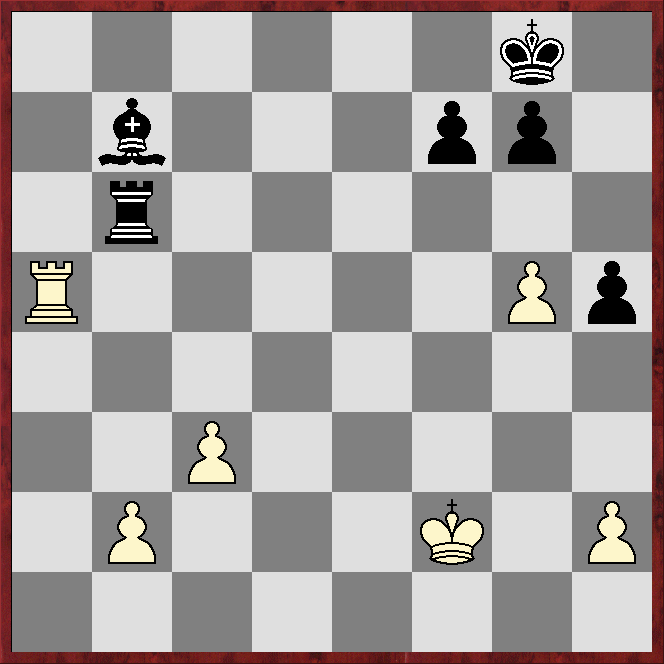U2000
1.Nc3
1.Nc3 e5 2.Nf3 Nc6 3.d4 d5?!
A gambit that probably is not sound but at least has surprise value.
4.Nxe5 Nxe5 5.dxe5 d4 6.Nb5 c5 7.e3 a6
Not 7...dxe3? 8.Qxd8+ Kxd8 9.Bxe3, after which White is a pawn up, ahead in development and has deprived Black of castling rights.
8.Nd6+
Stockfish15 and Komodo13.02 prefer 8.Na3.
8...Bxd6 9.cxd6 Qxd6 10.c3 Nf6 11.exd4 0-0 12.Be2 Bf5
 |
| For a pawn Black has a large lead in development, but White has the bishop-pair and no weaknesses |
*****
*****
*****
*****
13.0-0 Rad8 14.Be3 Qe6 15.Re1 Ne4 16.Qb3 Qxb3 17axb3 cxd4 18.Bxd4 Nd2 19.Rad1?!
Giving back the pawn with the aim of catching up in development and using the bishop-pair to exploit the awkward position of the knight. The engines much prefer holding on to the pawn with19.Bd1.
19...Nxb3 20.Bb6 Rxd1 21.Rxd1 Re8 22.g4?
Solving the back-rank mating threat, but Black has a good reply, so better is 22.f3.
*****
*****
*****
*****
*****
22...Be4?
The engines point out 22...h5, when they reckon 23.Bxa6 Bxg4 is completely equal.
23.f3 Bc6 24.Bc4 Ba4 25.Bxb3?
White is well on top after 25.Bd5.
25...Bxb3 26.Rd7 h5! 27.g5 Ba4 28.Rxb7 Bc6 29.Ra7 Bxf3 30.Rxa6??
This loses a piece.
30...Re6 31.Kf2 Bb7 32.Ra5 Rxb6
 |
| White has the more-active king and a pair of queenside passers, but they are a long way from even threatening to queen |
*****
*****
*****
*****
33.b4 Rc6 34.Ra7 Ba6 35.h4 Bc4 36.Ke3 Kh7 37.Kd4 Kg6 38.Rb7 Ba6 39.Rb8 Rc4+??
It is a check, but it loses the bishop.
40.Kd5 Rxc3 41.Rb6+ Kf5 42.Rxa6 Kg4 43.b5 Kxh4 44.b6 Kxg5 45.Ra5 f5
Not 45...Rb3?? 46.Kc4+ and Kxb3.
46.Rb5?
White gets a tablebase draw with 46.b7 Rb3 47.Kc6 Rxb7 48.Kxb7.
46...Rc8 47.Ke6 g6 48.Kd7 Rb8 49.Kc7
*****
*****
*****
*****
49...Rf8
The engines give the only winning move as 49...Rh8!, eg 50.b7 h4 51.Rb3 (51.b8=Q Rxb8 is a tablebase win for Black) Kg4 52.Rb6 h3! 53.Rxg6+ Kh5! 54.Rg1 f4 55.b8=Q Rxb8 56.Kxb8 Kh4 57.Kc7 f3 58.Rg8 h2 59.Rf8 Kg3 60.Rg8+ Kf4 61.Rh8 f2 etc (analysis mainly based on the Syzygy endgame tablebase).
50.Rd5?
Drawing is 50.b7 h4 51.Rb3 Kg4 52.Rb6 g5 53.Rf6! Rh8 (53...Rxf6 b8=Q is a tablebase draw) 54.Rh6! etc.
50...h4 51.b7 h3 52.Rd7
Or 52.Rd8 Rxd8 53.Kxd8 h2 54.b8=Q h1=Q with a relatively easy queen-and-pawn ending for Black.
52...h2?
The pawn should be supported, either by 52...Rh8 or 52...Kg4.
53.Rh7 Kg4 54.Rxh2 Kg3 55.Rd2 f4 56.Rd8 Rf7+ 57.Rd7 Rf8 58.Rg7 f3 59.Rxg6+ Kf2 60.Rf6!? Rxf6 61.b8=Q Kg2 62.Qg8+ Kf1 63.Qc4+
Komodo13.02 at first reckons White is winning, but soon (correctly) agrees with Stockfish15 that the position is drawn.
63...Kg2 64.Qg4+ Kf1 65.Qh4 Ke2 66.Qxf6 f2
The position is a well-known book draw, but I played on in the hope of inducing a mistake.
The game finished:
67.Qe5+ Kd1 68.Qf6 Ke2 69.Qe5+ Kf3 70.Qb5 Kg2 71.Qb2 Kg1 72.Qd4 Kh1 73.Qd1+ Kg2 74.Qe2 Kg1 75.Qe3 Kg2 76. Qe2 Kg1
JH offered a draw.
77.Qg4+ Kg1 78.Qh3+ Kg1 79.Qg3+ Kh1 ½–½

No comments:
Post a Comment